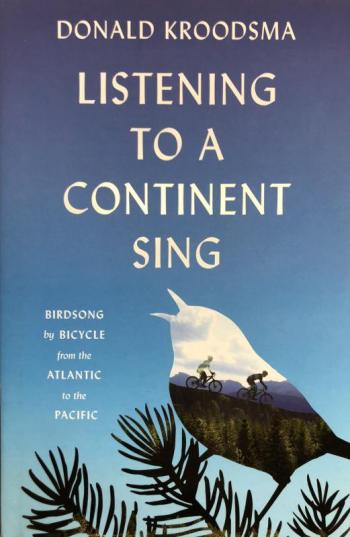Listening to a Continent Sing
Imagine being able to glide slowly over the ground at dawn somewhere along the Atlantic Coast of North America, listening to the songs of birds as they awaken on a spring day. Now imagine doing this listening glide across the whole continent, past fields and forests, suburbs and cities, through local and national parks, over rivers and streams, and up and down mountains, until you reach the Pacific Coast.
Famed ornithologist and birdsong expert Don Kroodsma imagined such a thing.
And then he found a way to make it happen.
In his book, “Listening to a Continent Sing” (2019, Princeton University Press), Kroodsma recounts a trip by bicycle that he and his son made in 2003 from Virginia to Oregon, starting in early May and arriving at the Pacific Coast in early July. After a lifetime of work, teaching, and research, Kroodsma’s journey is not only an exploration of birdsong along a monumental continentwide transect but a chance for him to reflect on what he wants to do next in life.
There is probably no other ornithologist today with the depth of knowledge of the intricacies of North American bird acoustic behavior, development, and geography as Don Kroodsma. As he traverses the country, waking up before dawn, and listening and recording what he hears, the reader is given an unparalleled view into a world few people experience and no one but Don understands to the extent that he does.
Even on his first morning, as he eagerly awaits the start of the trip and is disappointed to hear rain falling on the tent, he begins listening to the birds beginning to sing. He hears a robin start up an hour before sunrise and then a wood thrush with its “low, rich, flute-like, ee-oh-lay prelude…” Soon Kroodsma lapses into thoughts about how these thrushes can sing two notes simultaneously because of their two voice boxes, of the “unbroken string of successful ancestors” represented in evolutionary lineages, and of how the male Carolina chickadees he’s hearing are singing many different song patterns to show off their prowess to potential mates.
In diary fashion, Kroodsma recounts his mornings and his days of bicycle riding (sometimes as much as 100 miles a day) across the continent. His daily accounts are filled with descriptions of the sounds of the ever-changing bird communities that he and his son encounter along the way, all through the viewpoint of a singular avian acoustic expert who loves to learn and loves to share his knowledge with the reader.
Eventually, the southeastern birds that he is hearing—summer tanagers and Kentucky warblers, for example—disappear as he moves westward, replaced for a time by grassland-loving Henslow’s sparrows and dickcissels, and then eventually by western birds like Say’s phoebes, western tanagers, and black-headed grosbeaks as he and his son cross the Rocky Mountains and make their way to the Pacific Coast.
One remarkable aspect of the book is that throughout, there are bar codes in the margins of the pages whenever a bird sound is mentioned that, with a scan of a cell phone camera, will open a website where the reader can listen to the sound Kroodsma describes. While some readers may not wish to interrupt their reading to listen to all of the 381 sound recordings, it is fun and instructive to occasionally stop and scan and listen to what has just been described in words. Additionally, Kroodsma often includes detailed notes on the web page with the sound for more background. In fact, even without the book, anyone can enjoy the sounds of Kroodsma’s journey across the continent by going to the website: ListeningToAContinentSing.com. We recommend both the book and the website!
Jeffrey V. Wells, Ph.D., is a Fellow of the Cornell Lab of Ornithology. Dr. Wells is one of the nation's leading bird experts and conservation biologists and author of “Birder’s Conservation Handbook”. His grandfather, the late John Chase, was a columnist for the Boothbay Register for many years. Allison Childs Wells, formerly of the Cornell Lab of Ornithology, is a senior director at the Natural Resources Council of Maine, a nonprofit membership organization working statewide to protect the nature of Maine. Both are widely published natural history writers and are the authors of the book, “Maine’s Favorite Birds” and the newly published “Birds of Aruba, Bonaire, and Curaçao” from Cornell Press.































